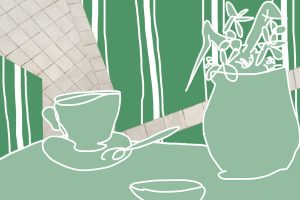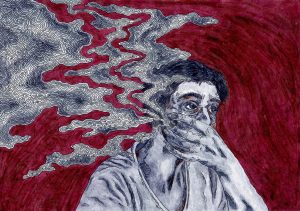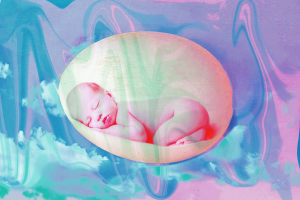
Meditations on Morisot
by Ashleigh Chow | March 31, 2023
To my mother, who taught me the language of painting.
Berthe Morisot (1841-1895): Impressionist painter, woman, mother.
While her counterparts, the Impressionists, became known for their radical paintings of landscapes and Parisian nightlife, art history portrayed Morisot as a mother. Over the years, she morphed into the blueprint for pictorial depictions of family life, often at home or in her garden.
Although we remember Morisot as a mother, she did not live to see her daughter Julie Manet beyond her teenage years. On 2 March 1895, when Julie was only 16, Berthe died. My mother, however, has lived long enough to see me turn 23.
Once, in the middle of an argument with my mother, she lamented that she wished I was young again. I often wonder, had Morisot lived long enough to see Julie older than sixteen, would she think the same too?
Julie Daydreaming (1894)
Resting her face on the palm of her right hand, the teenage Julie stares glossily outward. Her lips tip ever so slightly downwards while her white linen dress illuminates the picture, her shadows almost suggestive of a halo. Is she a moody adolescent, or a sentimental young woman? The artist is not visible, but I imagine Morisot’s eyes traversing the silhouettes of Julie’s figure, tracking her eyes, nose, her white dress – this moment engraving itself into Morisot’s mind as she transcribes it onto her canvas.
As I stare through the window of my room at the frosty fields outside, I reflect on the shifts in my life: new cities, new friends, new conflicts… But through Morisot, the last of Julie is immortalised at sixteen; our memories of her are now defined to that crystalline age.
Woman and Child in a Meadow at Bougival (1881)
Radiating from the picture are Morisot’s tender brushstrokes, their fuzziness surrounding the infant Julie. In it, she evokes the unreliability of memories, of growing up, capturing the vivid vagueness of that very unreliable nature. Our eyes suggest that Julie is playing with her mother as she hops around the grasses, picking up little daisies along the way. Except that lady is not her mother: it is Paisie, Julie’s wet nurse, a woman paid to take care of Julie. Instead, we find ourselves standing in the position of Berthe – the painter herself – a mere observer of this moment.
The idea of motherhood has always been complex. The definition of the job and what a mother ought to do has never been clear-cut. Yet we feel confined to these concepts from childhood: the mother, a carer, the daughter, a receiver. As time passes, the roles reverse: the daughter becomes the carer, while the mother is cared for. But Paisie, rather than Morisot, takes the role of Julie’s carer. While art history associates Morisot with motherhood, the complex dynamics of the mother-painter unravel before our eyes.
Motherhood is a story to be disentangled. In Oxford, our art history library holds four biographical monographs on the life and art of Berthe Morisot. What would my mother’s story be? Would I ever be able to know it?
Berthe Morisot drawing, with her daughter (1889)
I remember being shown a drypoint print of Morisot and Julie in one of my printmaking classes. In drypoint etching, the artist scratches a copper plate using a sharp tool before applying ink to the scrapings, creating rich but hazy black lines on the printed image.
In the print, Morisot holds onto the copper plate as Julie leans over to observe the drawing in action. Although Morisot appears to be gazing out to the viewer, she is probably looking at a mirror, as she incises her reflection onto the plate in her hands. Within the space in which the print is being created, we occupy the space of the mirror.
They say that children are often reflections of their mothers – a mirror image of who they were and who they could have been. Yet I have grown up so differently from my mother that I often wonder if this is true. While she speaks to me in Cantonese, I reply grudgingly in English. She is from Hong Kong; I am not really. Driving through the streets of Hong Kong on one of our trips to visit family, our eyes lift to the neon-lit signboards. They are distinctive, but not many of them exist anymore. My mother recalls her childhood: when my grandmother took her to eat dim sum, her first time at the newly opened McDonald’s, eating wonton noodles.
But more than that, she always remembers us: “This is where you cried because you had sand in your eyes”; “Do you remember when you asked to put brandy in your hair because you heard it would make your hair grow faster?”; “Your teacher always said you were such a bubbly child.”
I remember very little of my childhood. I don’t know how much I’ve changed. But to my mother, it is as clear as a mirror. We have always been a part of her.
Portrait of a Woman (1872-1875)
I forget that my mother was once my age. That she is a daughter, too. That one day, she left home and grew up.
Last year, I took my mother to my workplace, an art museum in London featuring one of Britain’s most significant collections of Impressionist paintings. I tell her that Morisot is the only female painter on display in the gallery, as we stood in front of Berthe Morisot’s Portrait of a Woman. Coming face-to-face with the woman in the portrait, I explain that art historians think that she was Morisot’s sister. Dressed in a beige and brown day dress complete with a pleated edge, Morisot presents a quietly refined woman, adorned with matching gold earrings. She is polished but candid.
My mother, amused, moves closer to see the artist’s workmanship. She comments that the woman in the portrait has an interesting blank facial expression, that despite the painter’s sparing use of brushstrokes, her dress is very beautifully painted. I nod and agree with her observations, even though ‘realistic’ is a long-disputed word that art historians do not use.
At some point while I was in university, I learnt the language of art history. While my sisters, both medics, converse in fluent ‘science speech’ with my mother, a dietitian, I never found a place in those conversations. But I also learnt about other things, from how imperial botanical drawings captured the 18th century British imagination, the erudite merging of poetry and painting by Ming Dynasty literati, to how tiny pilgrim badges held stories of sacred journeys.
I think my mother is proud of me, anyway. But I also don’t think she knows that in those moments of holding my hand and paintbrush as a child, she taught me the language of painting many years ago – something I’ve clung onto deeply.
***
I never quite understood why I always felt drawn towards images of daily life. But I realised one day that the quiet and the quotidian share a similarity: they expose the moments typically overlooked, the thoughts and experiences that are not well-articulated through speech. It is just like those fleeting thoughts of affection, just like the fleeting thought of ‘I love you’, just like memory – you forget them quickly enough.
Stroke by stroke, capturing Julie’s every feature through the wand of her brush, Morisot watched her daughter grow up. Day by day, as I grew 23 years older, my mother grew 23 years older too.
Exactly 101 years before my mother and father’s wedding day, on 18 October 1893, Julie wrote in her diary, “I am making a resolution to get up earlier tomorrow, to work and to be nice to Maman.”
Me too.
∎
Words by Ashleigh Chow.
Art by Evelyn Homewood.




